It has been hailed as “Disneyland for scientists” and the “Swiss Army knife of boats”.
Australia’s new Antarctic vessel, RSV Nuyina, has been settling in to life on Hobart’s waterfront in recent weeks after making a 24,000km delivery journey from Europe.
The 160m long, 50m tall, 25,000 tonne ice-breaker is hard to miss, with its bright orange paintwork and imposing stature. And yes, its predecessor – RSV Aurora Australis – was also a bold orange hue. But that 94m-long ship would be dwarfed by the faster, flashier Nuyina.
However, it’s what’s tucked away inside the shiny new $529m research vessel that’s most impressive, with Australian Antarctic Division director Kim Ellis hailing Nuyina as “the most powerful research ship in the ocean at the moment’’.
Onboard the purpose-built vessel, you can find everything from a gym, a sauna and a theatrette to comfortable cabins and state-of-the-art laboratory equipment akin to futuristic gear you might expect to see in science fiction films.
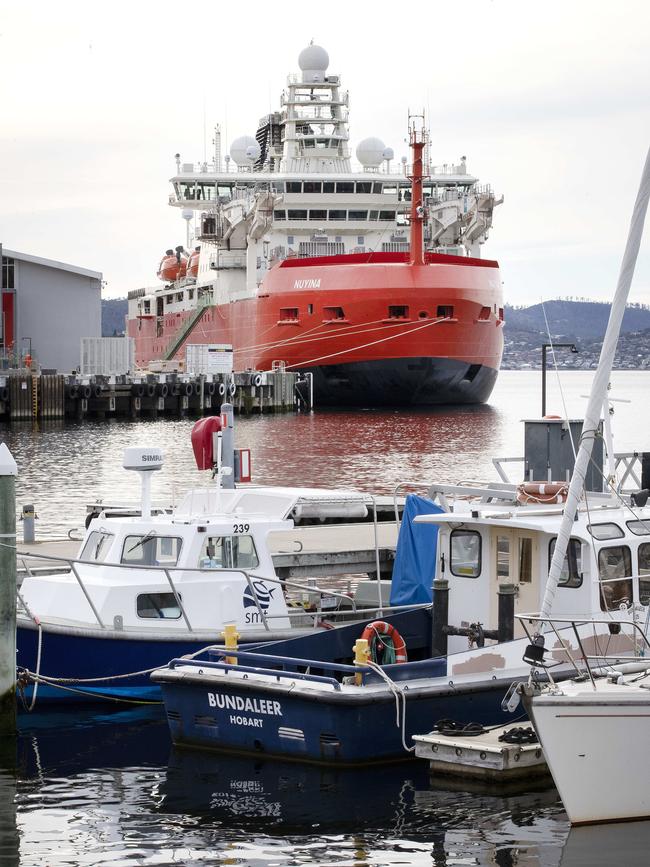
A moon pool, wet wells and drop keels are among the hi-tech offerings on the ship, which is capable of carrying 117 expeditioners and 32 crew.
By comparison, the Aurora Australis could carry a total of 114 expeditioners and crew.
Moveable science labs, powerful cranes, amphibious vehicles and a helipad with helicopters that can cover a far greater aerial range than has previously been possible in Antarctica are among the highlights.
“It’s as big and as complicated as any of the navy warships – it’s a remarkable vessel,’’ Ellis says of Nuyina, which is the centrepiece of the federal government’s Australian Antarctic Strategy. A $1.9bn package covers the design, build and 30-year operational and maintenance lifespan of the icebreaker, representing the single biggest investment in the history of Australia’s Antarctic program.
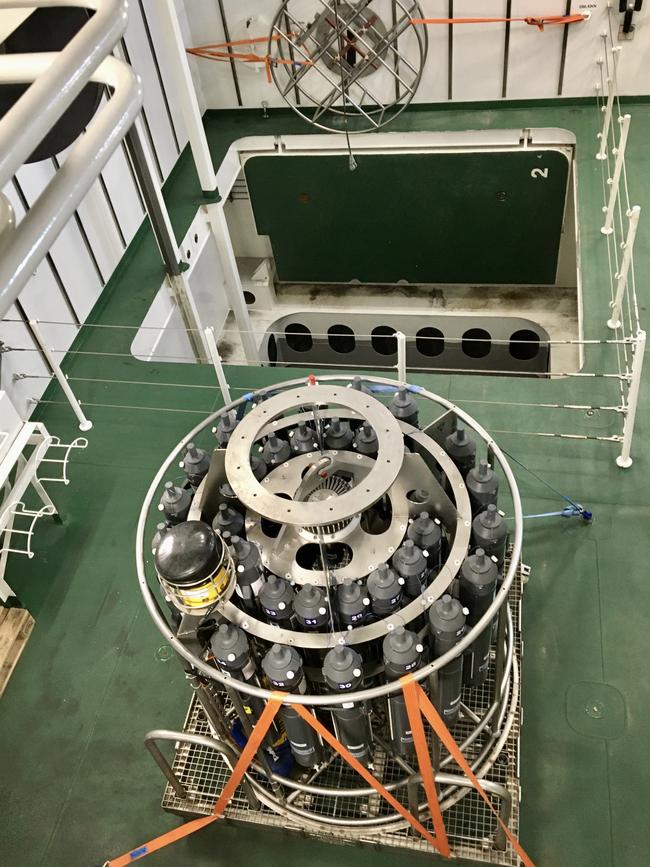
Ellis says the Aurora Australis was a “great ship” but as its lifespan drew to a close, attention had to be turned to creating a bigger and better ship that could adequately support Australia’s endeavours in Antarctica, moving forward into the next 30 years.
Aurora Australis was owned by P&O and leased by the Australian Antarctic Division, but Nuyina is owned by the Australian Antarctic Division with Serco contracted to operate and maintain the vessel.
Ellis says although planes regularly fly in and out of Antarctic these days – he actually flew down the day after our interview – boats remain the mainstay of Antarctic exploration.
Ships supply fuel, food and maintenance equipment, among other essential supplies – the
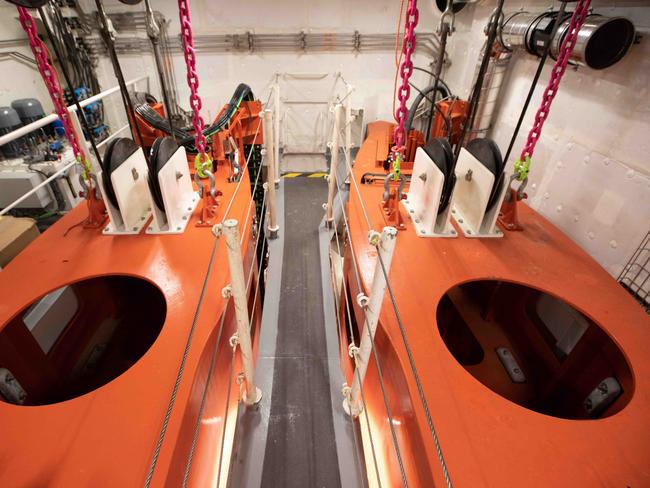
Nuyina can accommodate 96, 20-foot containers and can carry 1200 tonnes of cargo, a significant step up from the Aurora Australis where goods bound for Antarctica had to be packed in an assortment of boxes, bags and sacks. The Nuyina can also carry 1.9 million litres of special Antarctic blend fuel and is powerful enough to break 1.65m of ice at a continuous speed of three knots, quiet enough to allow researchers to use acoustic instruments, and large enough to resupply two of Australia’s four Antarctic and sub-Antarctic stations in one voyage.
The RSV Aurora Australis was named for the southern lights that can be seen in Antarctica and Tasmania, and the Nuyina continues this tradition – the name nuyina means ‘‘southern lights’’ in Tasmanian Aboriginal language palawa kani.

The Nuyina will be joined by two other Antarctic ships in Hobart in coming weeks – one is the Happy Dragon, a big yellow 145m ice-strengthened cargo ship which will be arriving from The Netherlands, and the other is a 110m blue American icebreaker called Aiviq which is affectionately known as the Walrus (its name means walrus in Inupiaq, the language spoken by Indigenous Alaskans).
The boats will ensure Antarctic supply is not disrupted. Although Nuyina is raring to go, the boat and all its hi-tech equipment must be adequately commissioned – and staff trained to use it – before the ship can embark on a full Antarctic voyage.

The Nuyina will head to Antarctica for a couple of short journeys in late December and early February, but will spend this Antarctic season and next getting everything working perfectly onboard before operating at full capacity for the 2023-2024 season.
Despite the seemingly slow start – Ellis says many Tasmanians expected the ship would arrive in the state and instantly be ready to make a full journey south – the fact that it even made it to Hobart is quite remarkable.
The ship was built in Romania at the height of the coronavirus pandemic.
Planning for the new vessel began 10 years ago. Ellis says the first six of those years were spent getting the user requirements right while also forecasting what would be needed well into the future.
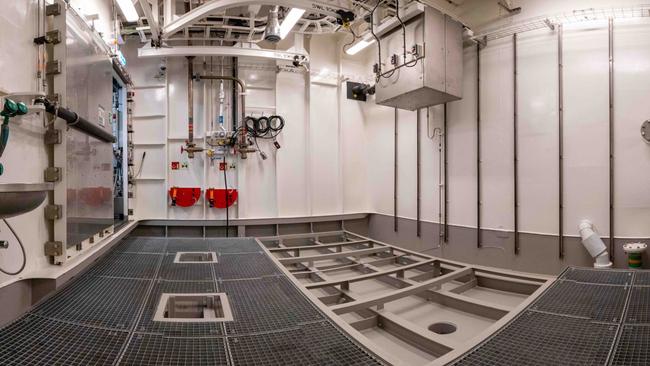
Then came the more detailed design and taking it to market to find someone who could build it, before construction eventually began.
But no one could have foreseen the pandemic.
Ellis says the Romanian shipyard where the boat was built, owned by Dutch company Damen, is considered one of the world’s best. But the country was badly hit by covid, with outbreaks among staff at the shipyard. Specialists were also unable to fly in to work on the boat due to travel bans.
The ship was about 95 per cent complete at that point, but the project was increasingly delayed.
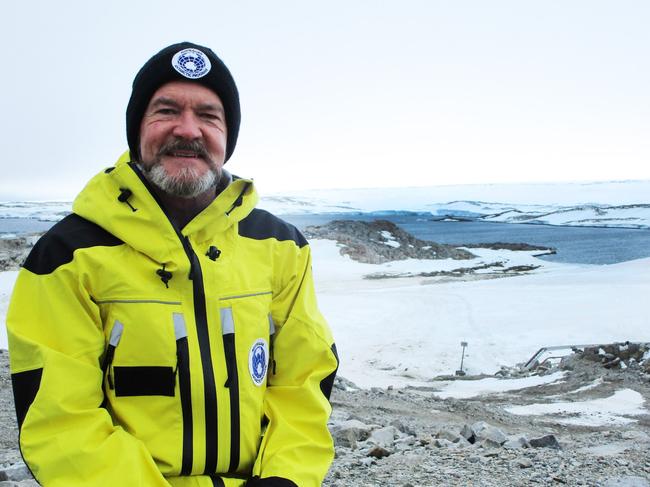
So, Ellis says, a bold decision was made to tow the giant ship down the Danube and into the Black Sea, the Mediterranean Sea and Strait of Gibraltar to get to The Netherlands – an almost 7000km journey. Special permission had to be sought to move the vessel and declare it seaworthy, as it wasn’t able to operate under its own power.
“It was a very complex and challenging process, and very weather-dependent,’’ Ellis explains.
But the gamble paid off – the ship arrived safely in The Netherlands and after a couple of months, work on propulsion, electrical and navigation systems was complete, allowing for sea trials to be carried out and the ship to eventually be transported to Tasmania.
“Had we left it there [in Romania] the ship would have been delayed significantly longer,’’ Ellis explains. “It was no fault of the shipyard or the builder; it was just a consequence of the covid outbreak.’’

The pandemic also meant the ship didn’t get the celebratory welcome Ellis had been hoping for.
The ship arrived in Hobart on Saturday, October 16, the weekend of Tasmania’s snap three-day lockdown, meaning the crowds of onlookers that had been expected to line the waterfront to watch the boat arrive did not eventuate.
Despite this, Ellis – who first visited Antarctica more than 40 years ago as an army officer specialising in amphibious operations before stepping into the role as Australian Antarctic Division director three years ago – says there’s been a real buzz in the community about the ship since its arrival.
He fondly recalls an early visit to the ship, where staff were enjoying a walk-through of the facilities and being briefed on various pieces of equipment.
“They looked like kids in a lolly shop,’’ the 66-year-old says.
“They had grins from ear to ear because this is equipment we’ve never had before.
“Many of them helped with the design of this ship, so now to see it on the ground and working is so satisfying.’’
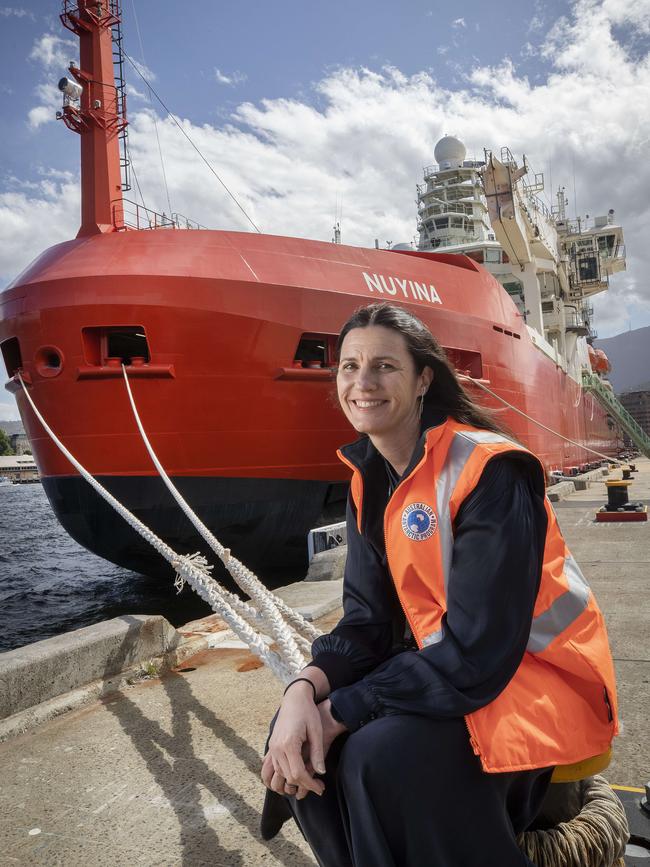
Among those staff members is Nicole Webster, the Australian Antarctic Division’s chief scientist.
The 48-year-old moved her husband and three teenage children to Hobart earlier this year so she could work on Nuyina after many years living and working in Townsville.
And although much of Webster’s recent work involved studying the Great Barrier Reef, she says many of the same questions and challenges apply here, despite the differing latitudes.
And she’s excited for Nuyina and what it means for the future of science.
“It’s so incredibly exciting – we’ve never had capability like this before,’’ Webster enthuses.
“We are going to be able to do science that we haven’t ever been able to do before.
“It’s been an incredibly steep learning curve to get up to speed with Antarctic science and get my head around this incredible new vessel.
“The environment is facing some very real and very large challenges as we move forward in this time of climate change. And many of the challenges faced by the Great Barrier Reef – like ocean warming and acidification – are the same challenges in Antarctica that we need answers and solutions for. They are two of the fastest-changing environments on our planet … there are a lot of parallels.’’

Webster actually spent time in Antarctica early in her science career through the New Zealand Antarctic Division, where she dived beneath the ice to collect marine samples.
And she says it’s a place that has been dear to her ever since.
“I think Antarctica is such an incredible environment. You know it’s so extreme and so remote and so stunningly beautiful and I had always wanted to go there,’’ she explains.
“Once you’ve experienced it once you fall in love and I think you’ve got that lifelong commitment to Antarctica.’’
Webster says it has been a busy time since Nuyina arrived, with a lot of work required to get the ship’s new systems up and running and adequately tested in preparation for research to begin.

The onboard multi-purpose laboratories can be configured in a variety of ways depending on the type of research being carried out over the next 30 years.
And most excitingly, she says, are features like the moon pool, drop keels and wet wells.
The moon pool is a big open area in the middle of the ship with a 13m shaft which allows direct access to the water below, even if the ship is surrounded by ice.
Scientists can put down sensors, deploy remotely-controlled submarines or other vehicles to examine the sea floor or get a closer look at sea life.

Meanwhile the drop keels are like regular keels on a boat but are filled with sensors and can be lowered about 3m beneath the ship – well below the turbulent bubble layer immediately underneath the vessel – to measure things like sound, water temperature and salinity.
Webster says underwater cameras can be attached and used to get a more realistic understanding of how marine mammals behave in their natural environment.
Wet wells are ports in the side of the ship that can open to pump in up to 5000 litres of sea water per minute as well as the microorganisms in the sea water.
Webster says previously, if scientists wanted to collect specimens, they would have to put fine nets over the side of the ship and then go through the nets to take out small marine creatures which sometimes suffered damage in the process. And some organisms were too tiny to be caught in the nets.

Wet wells enable things like krill and jellyfish to be captured more easily, without the need to touch or damage them. They can then be put into aquariums for monitoring. Webster says the equipment has already been used to pull up Derwent Estuary shrimp from the River Derwent in pristine condition.
“I actually had a moment, standing on the back deck when I did my first induction on [Nuyina], almost standing there in disbelief of having this ship here at our disposal,’’ Webster says.
“It was a moment of reflection on just how lucky I am to be in a position where I can shape the future of Antarctic science and have amazing infrastructure to enable that.’’
Lots of testing – of amphibious craft, helicopters, cranes and other equipment – has been carried out in the River Derwent in recent weeks and will continue in the coming days. More helicopters are yet to come – new medium-lift helicopters will allow a 500km travel range from the ship, compared to the 100-150km that can currently be covered. The ship is also due to head to Burnie soon to refuel and do shallow-water coastal trials along the way before returning to Hobart in preparation for the ship’s first test voyage to Davis and Casey stations on December 20 and another to Mawson station and Macquarie Island on February 1. Nuyina fits within the physical limitations set out by TasPorts for transiting under the Tasman Bridge but guidelines are still being formulated for this transit, so until Selfs Point can be accessed, refuelling is likely to be done in Burnie or in Hobart via tankers /barges.
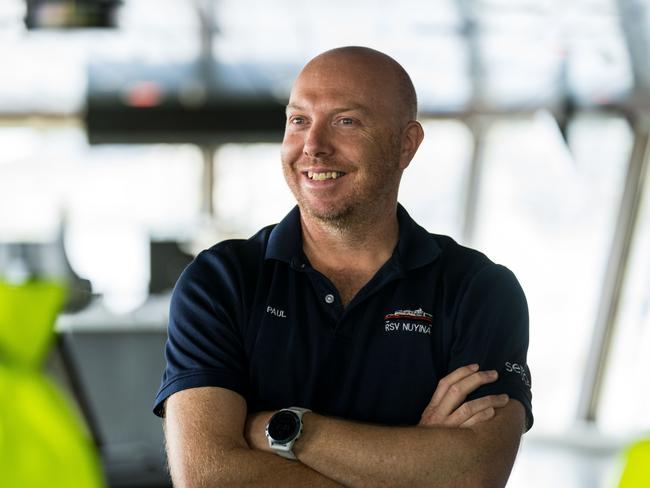
Master Paul Clarke is one of Nuyina’s two captains (they work an alternating roster) and he says landing the role was a dream come true.
Born and raised in the Falkland Islands – “which, like Hobart, is a gateway to the Antarctic” – Clarke began working for the British Antarctic Survey as a deckhand. He was just 16 when he first started working on ships and by 19 seafaring had become his full-time occupation.
Clarke spent 11 years working for the British Antarctic Survey, undertaking more than 20 voyages to Antarctica. He has spent the past decade sailing as a Master of supply vessels for shipping company Solstad/Farstad in the oil and gas industry in various parts of Australia, including Western Australia and the Northern Territory, as well as in South-East Asia, India and Europe.
He moved to Australia eight years ago and is currently based in Brisbane but will fly in and out of Hobart to work on RSV Nuyina.

The 47-year-old says he’s always aspired to become the Master of an Antarctic research vessel.
“This is an amazing opportunity,’’ he tells TasWeekend as he steps out of a series of meetings onboard the ship to help the commissioning stage run smoothly.
“Becoming a Master was obviously a career goal for me, and I did that quite some time back. Then to have the opportunity to do it on one of the Antarctic research ships – somewhere that I started my career – it’s definitely a defining moment for me as a professional seafarer
“It’s a career goal, this type of job. There are not very many of these vessels worldwide – there’s only one in Australia.’’
Clarke flew to The Netherlands to conduct sea trails aboard the ship. He then flew back to Australia while the Nuyina’s other captain, Master Jerry O’Doherty, sailed the ship to Hobart. O’Doherty then handed over the reins to Clarke, who has helped settle the ship into its new home.
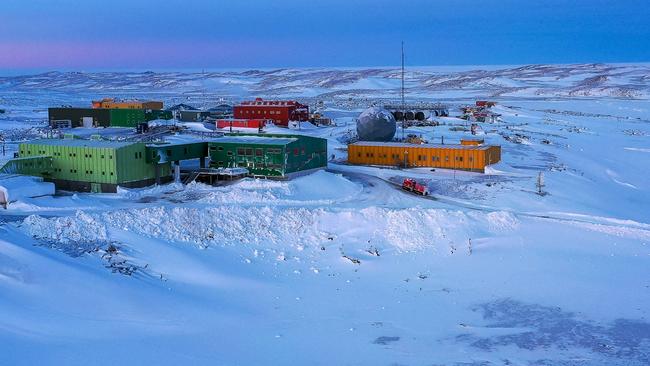
Clarke enjoys the challenges that come with working in icy, remote regions but says the “great bunch of people” he gets to work with is what makes the job special.
“I very much enjoy the type of ice navigation challenges, research and survey work that will be undertaken on the Nuyina,” Clarke says. “It does push you professionally.
“It’s a pretty exciting time, getting a ship that’s brand new and trying to get it operational – it’s a huge step from construction to operations, for sure.
“But I think the bit I really like is the people. The people do this because they really want to do it; they’re not doing it because it’s just a job. And that makes a big difference for everybody’s morale on the ship and enthusiasm for getting things done.’’
He says members of the public are fascinated by the Nuyina and the people who work on it. Curious onlookers sail past in boats while passers-by on foot often stop to investigate. And if they see crew coming and going many are keen to have a chat.
“There’s a lot of interest and excitement from the people of Hobart,’’ Clarke says.
“People are full of questions … they want to know ‘do we work on it?, what do we do?, how long does it go [away] for, are there any jobs?’.
“There’s quite lot of interest.’’
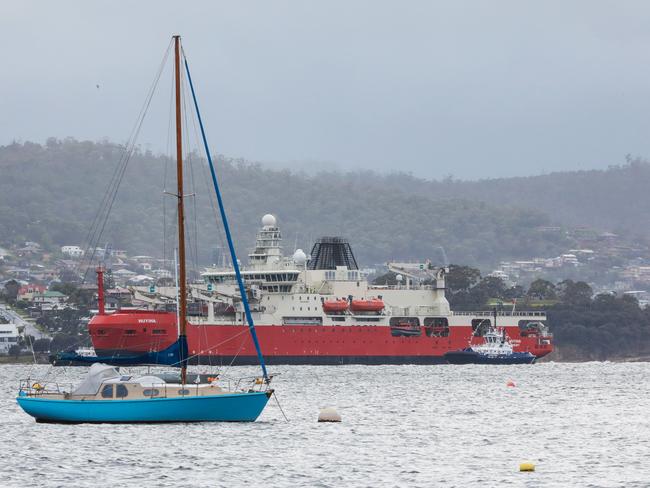
He says even among crew members who are seasoned Antarctic expeditioners there’s a palpable buzz in the air.
“It’s such an incredible place to work. We can see the excitement … some of our crew members have never been [to Antarctica],’’ Clarke says.
“It’s a hugely exciting time for all of the crew. We’re learning a lot of new skills, all of us, me included. “For me, it’s the fact that it’s never the same. I think I like that challenge – it’s different all the time. Some days it’s easy, some days are very hard, but it’s always pretty incredible.
“It’s such a long project, I could be here until I retire.”•

Add your comment to this story
To join the conversation, please log in. Don't have an account? Register
Join the conversation, you are commenting as Logout
Romance boom: Tassie author pens 100th book
Tasmania’s Ris Wilkinson became an author at 44 with romance juggernaut Mills & Boon. At 66, she’s penning her 100th book as Melanie Milburne – as writers converge on Hobart for a national event.
Coal River vineyard dishes up quiet culinary bliss
With a striking cellar door, smart seasonal menu and standout wines this vineyard is a must-stop in the Coal River Valley. Come for the views, stay for the food and a second glass of pinot ...